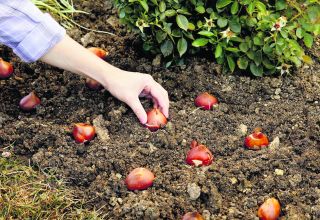The garden undergoes a lot of change as we head deeper into winter, as its colours begin to fade and gardening tasks become less demanding than in late summer. There’s however plenty to get on with to prepare for next year, and there’s still much produce to savour and enjoy.
1. Make improving your soil a priority
Perhaps the best task you can get on with over the next few weeks is to improve the soil for the next growing season.
It is a generally accepted fact that once soil temperatures drop below 45°F (7°C), biological activity slows to a crawl, and the soil and all its life forms hibernate through winter. By this logic, soil cannot be expected to change for the better during the winter months, and yet it does when given a little help.
1.In autumn it is better to mulch over vacant beds without cultivating them first.
2.Fallen leaves do a great job of protecting soil from the ravages of winter. But many other mulch materials work just fine, including wood chips – an increasingly popular mulch material in gardens with soil that has already been improved for several seasons.
3. Grow winter green manures. Many cold-hardy plants that make great winter green manures which are specialists at protecting the soil from erosion through winter, all the while developing huge root systems that increase soil organic matter content. When cut back to the ground in spring, winter green manures like hairy vetch or winter peas leave behind nodules of nitrogen, ready for use by the next crop.
4. Beds that will sit vacant until spring can be heaped up with compost (again without cultivating them first), and then covered with an old blanket or carpet. In this way, the bed benefits from a deep layer of compost at the surface, which is further enhanced by a cover which moderates how much moisture reaches the compost and soil below and cushions the bed, which reduces compaction caused by pounding rain.
2. Look after hedgehogs
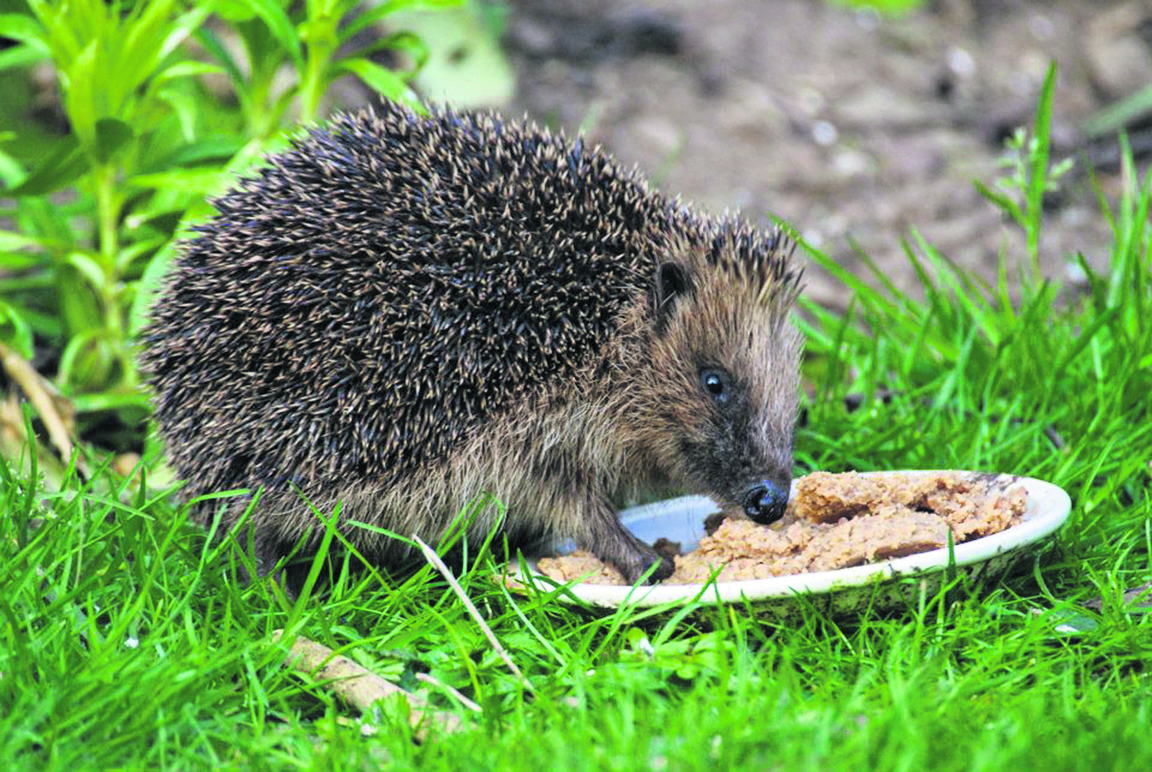 Depending on the temperature, hedgehogs will hibernate from November through to March or April. During hibernation, a hedgehog’s body temperature can fall to less than 10°C, its heart slows to fewer than 20 beats a minute and it virtually stops breathing.
Depending on the temperature, hedgehogs will hibernate from November through to March or April. During hibernation, a hedgehog’s body temperature can fall to less than 10°C, its heart slows to fewer than 20 beats a minute and it virtually stops breathing.
Hedgehogs build nests for hibernation under leaves or structures such as sheds or, unfortunately bonfires which is why it is essential to check before lighting.
It’s also well worth checking for hedgehog nests before chopping down any long grass. Hedgehogs are lactose intolerant, so ignore the old wives tale and don’t leave out a saucer of milk. Provide fresh, plain water instead.
Too much neatness (such as decking and neat and smooth fencing) won’t help them. Talk to your neighbours and, if they agree, cut 13cmx13cm holes in your fences or dig a channel beneath garden boundaries to connect your gardens.
3. Force chicory for winter salads
Force chicory to make tender, blanched heads (chicons) for winter salads. Buy plants in pots and cut back growth to leave short stubs. Put a bucket over the top, block out light with stones and put in a frost free place, such as a garage or shed. In several weeks, tender white chicons will have formed and you can cut at the base and repeat.
4. An easy shelter for helpful insects
Bundle together stems which have been cut from herbaceous perennials and leave them in a sheltered, hidden place. Anything from ladybirds and other beetles to small mammals will take shelter here, being on hand to tackle early pest infestations in spring.
5. Roses need our attention
It is an important time of the gardening year to keep your roses as healthy as you can. If you are planting new roses, it’s important not to plant them too closely so that air can circulate between plants. And try and keep plants strong and shapely by pruning out old and weak shoots every year between November and March.
On a day when the weather is neither icy nor frosty, arm yourself with a sharp pair of secateurs and prune your rose bushes. Pruning will encourage them to produce lots of flower buds on a well-shaped framework of branches with an open centre.
As it’s the younger stems that tend to produce the best flowers, the aim is to prevent the plant from becoming congested. Remove any dead, damaged, diseased or weak-looking stems completely. Then cut back the most vigorous stems to within 25-30cm or three or four buds above last year’s cut. And the thinner stems back a little harder. Always cut to an outward-pointing bud, making a sloping cut about 6mm above the bud.
As thorns don’t tend to rot, put the dead material in the dustbin instead of the compost—especially if the plant has been infected by disease.
6. Bare root plants – great value and a better choice
November to March is the ideal time to plant bare-root plants. These are plants that have been grown in open ground, then dug up for despatch and planting during the dormant season. They are called ‘bare-root’ plants as they are supplied with no soil around their roots.
Bare-root plants are generally cheaper than plants grown in containers, and you’ll often find a wider selection of varieties this way. Planting them in the dormant season means that they should establish well – while the top growth may be brown and twiggy, the roots are busy establishing beneath.
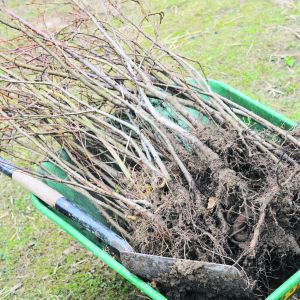 All kinds of plants can be supplied bare-root, from trees to perennials.
All kinds of plants can be supplied bare-root, from trees to perennials.
Planting a hedge is much more economical if you buy bare-root plants and while not ‘instant’, they will knit together quickly. It’s a great way to plant beech, hornbeam or an ‘edible hedge’ made up of a mix of edible plants such as blackthorn, cherry plum and Rosa rugosa.
You can buy container-grown roses all year round, but for the best selection, it pays to plant them bare-root.
Try to plant them as soon as they arrive. Otherwise, give them a good soak in a bucket of water then roughly plant in a corner of the garden until you’re ready to put them in properly.
7. Jobs in the winter vegetable patch
Start planning next year’s vegetable crop to allow for a good rotation of crops. Growing the same type of crops on the same ground each year can cause a build up of pests and diseases affecting that type of crop. Crops can be grouped as follows: roots, brassicas, legumes (peas, beans) and everything else (potatoes, onions, tomatoes). Move your crops around each year so that the same group of crops isn’t in the same area for more than one season.
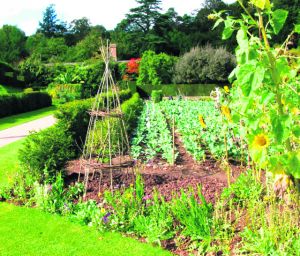 Sow pea tips. Sow a box or gutter pipe of pea tips inside, ready for salads, soups or risottos at Christmas. Scatter the seed across the length and width of the compost and put them anywhere cool, but in good light. Sown now, you can pick straight from the gutter pipe – no garden required.
Sow pea tips. Sow a box or gutter pipe of pea tips inside, ready for salads, soups or risottos at Christmas. Scatter the seed across the length and width of the compost and put them anywhere cool, but in good light. Sown now, you can pick straight from the gutter pipe – no garden required.
Sow hardy peas under fleece for an early crop next year.
Clear away climbing beans, then pull up, clean and store away canes and supports.
Improve soil, digging over bare ground and forking in bulky, well-rotted manure. Digging it now will allow time for cold winter weather to break down clay into a more workable soil.
Check stored potatoes for signs of rotting.
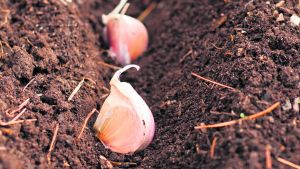 8. It’s perfect garlic planting time
8. It’s perfect garlic planting time
Now is the ideal time to plant out garlic which likes a period of dormancy and cold prior to growing away in the spring. If you have a heavy soil that tends to hold water there is the danger of the cloves rotting. To stop this, dib your planting hole as usual and then drop some sharp sand or fine gravel in the base of the hole. An inch of sand or grit will provide enough drainage to save the day. Fill the hole above the clove with compost and you should get them off to a great start.
9. Plant broad beans for early summer harvest
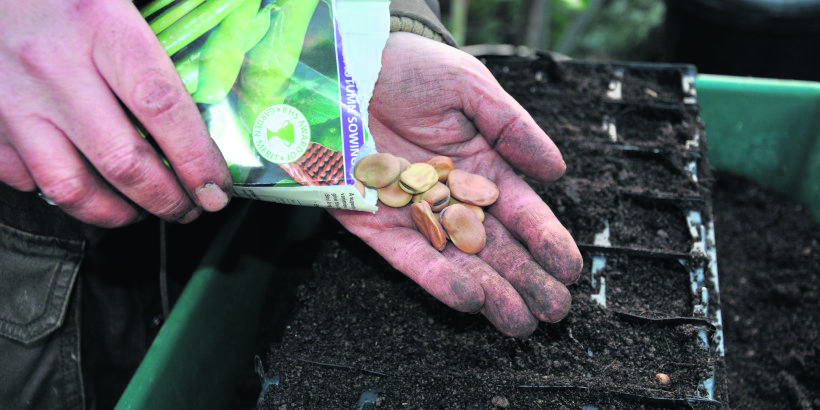 Broad beans are one of the easiest vegetables to grow as the seeds are big and easy to handle – this also makes them perfect to try with children. You don’t need any special kit either – just a bare patch of earth is all that’s needed to get a crop underway. Broad Bean ‘Aquadulce Claudia’ seeds sown in October or November will form sturdy plants before the cold of winter sets in, meaning they will be ahead of those sown in spring. The seedlings will survive the winter, grow as temperatures rise and produce an early-summer harvest. Sow two rows quite close to each other, around 20cm, the plants will support each other as they grow. These would need to be protected and work best in a more sheltered, southern garden.
Broad beans are one of the easiest vegetables to grow as the seeds are big and easy to handle – this also makes them perfect to try with children. You don’t need any special kit either – just a bare patch of earth is all that’s needed to get a crop underway. Broad Bean ‘Aquadulce Claudia’ seeds sown in October or November will form sturdy plants before the cold of winter sets in, meaning they will be ahead of those sown in spring. The seedlings will survive the winter, grow as temperatures rise and produce an early-summer harvest. Sow two rows quite close to each other, around 20cm, the plants will support each other as they grow. These would need to be protected and work best in a more sheltered, southern garden.
10. Winter herbs close at hand
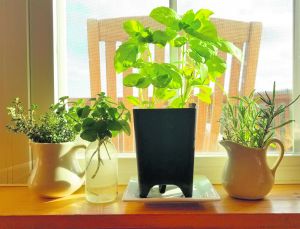 Choose your favourite herbs like basil, dill, chives and parsley that are all really useful to have to hand over the winter months. Pick a planter to suit your space – a recycled tin can be upcycled or choose an indoor window box or pretty herb pots that can often be bought in sets of three. Make sure you pick the sunniest windowsill or use an indoor growing light.
Choose your favourite herbs like basil, dill, chives and parsley that are all really useful to have to hand over the winter months. Pick a planter to suit your space – a recycled tin can be upcycled or choose an indoor window box or pretty herb pots that can often be bought in sets of three. Make sure you pick the sunniest windowsill or use an indoor growing light.
Sow one variety to each pot or you can put three varieties in a window trough. Cover the seeds lightly with vermiculite or a fine layer of the compost.
11. And finally…
It is of course time to take stock of your gardening year. Do not be disheartened by your gardening imperfections or failures, but devote some time to pondering what you will do differently in the coming year. One of the beauties of gardening is you can always try again.





